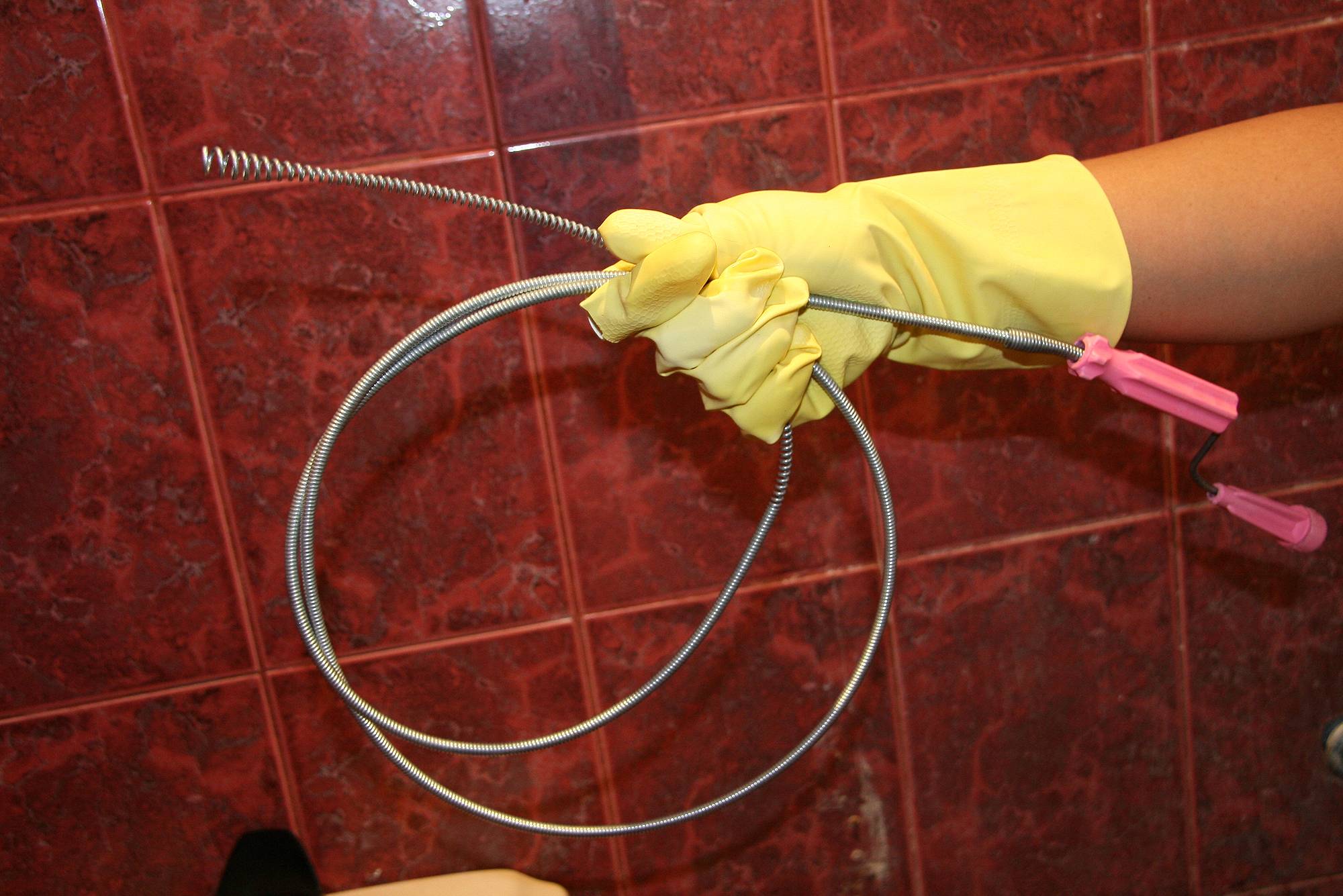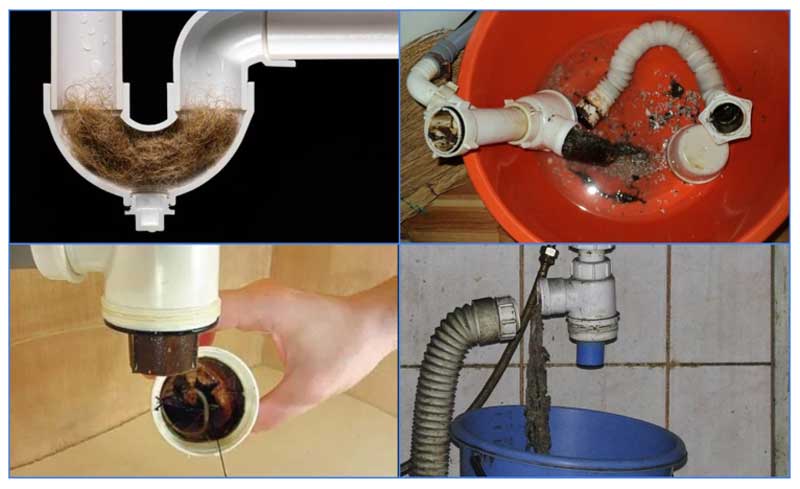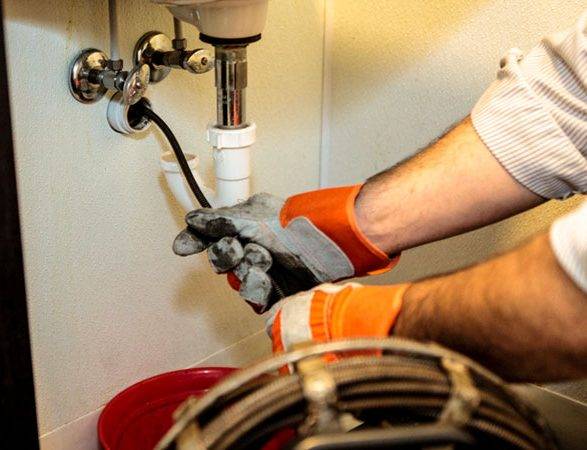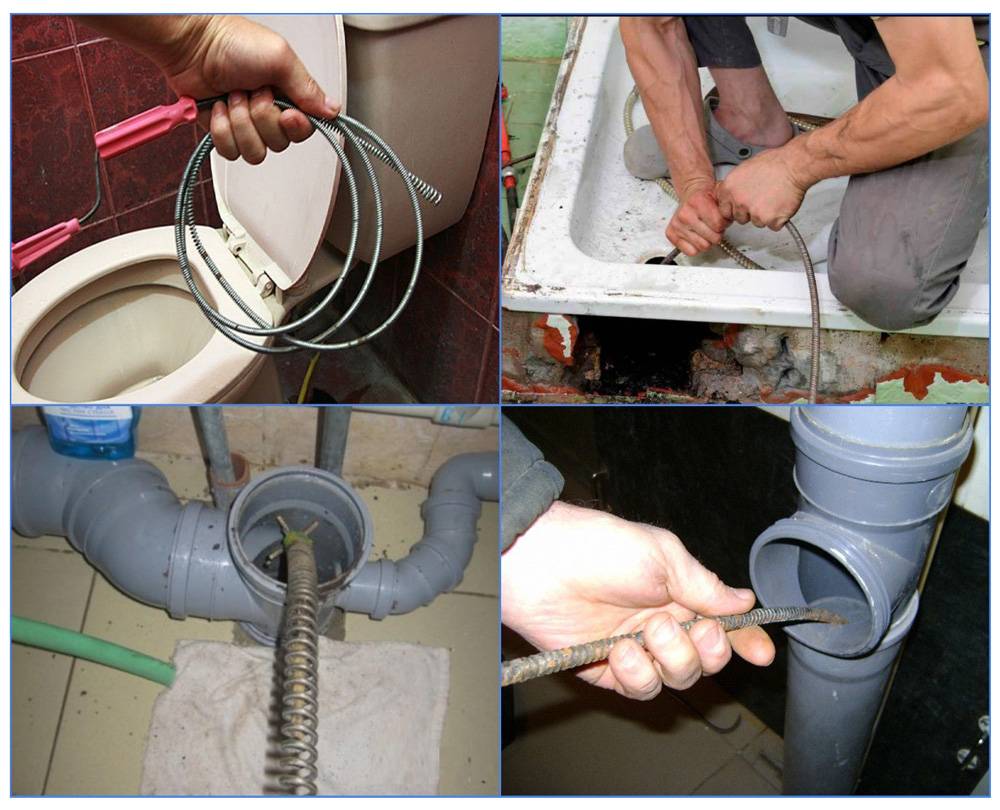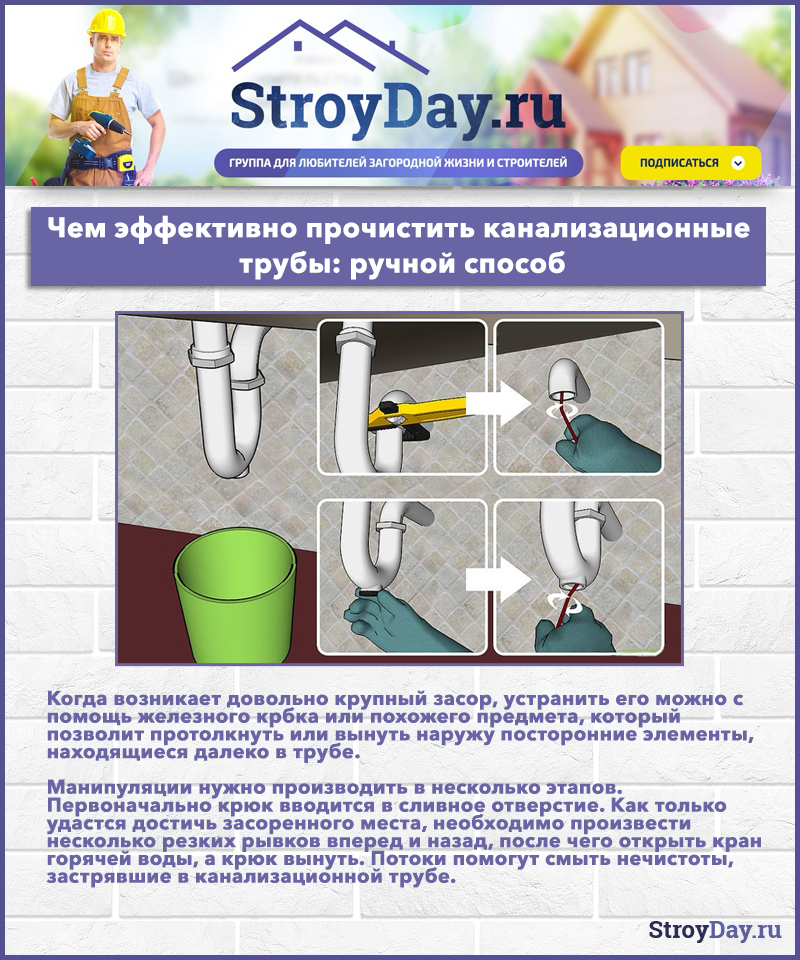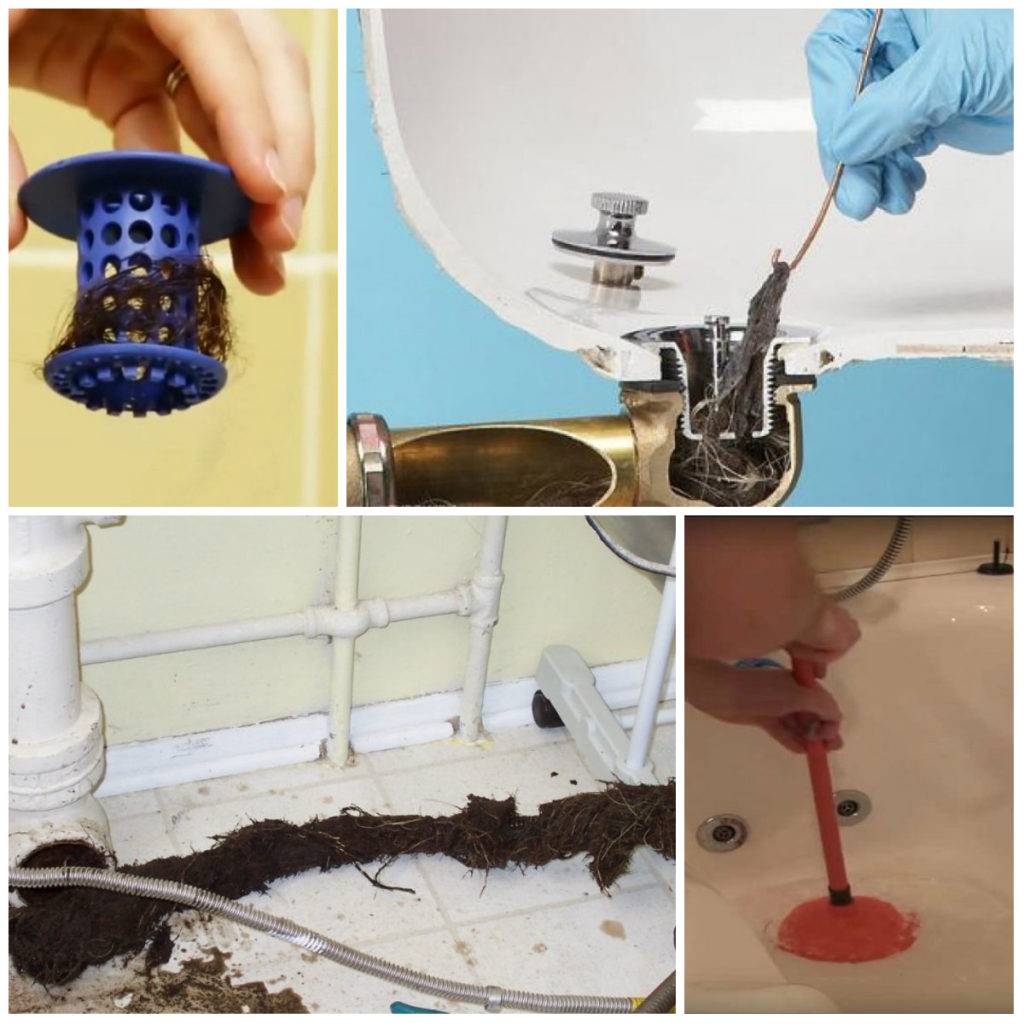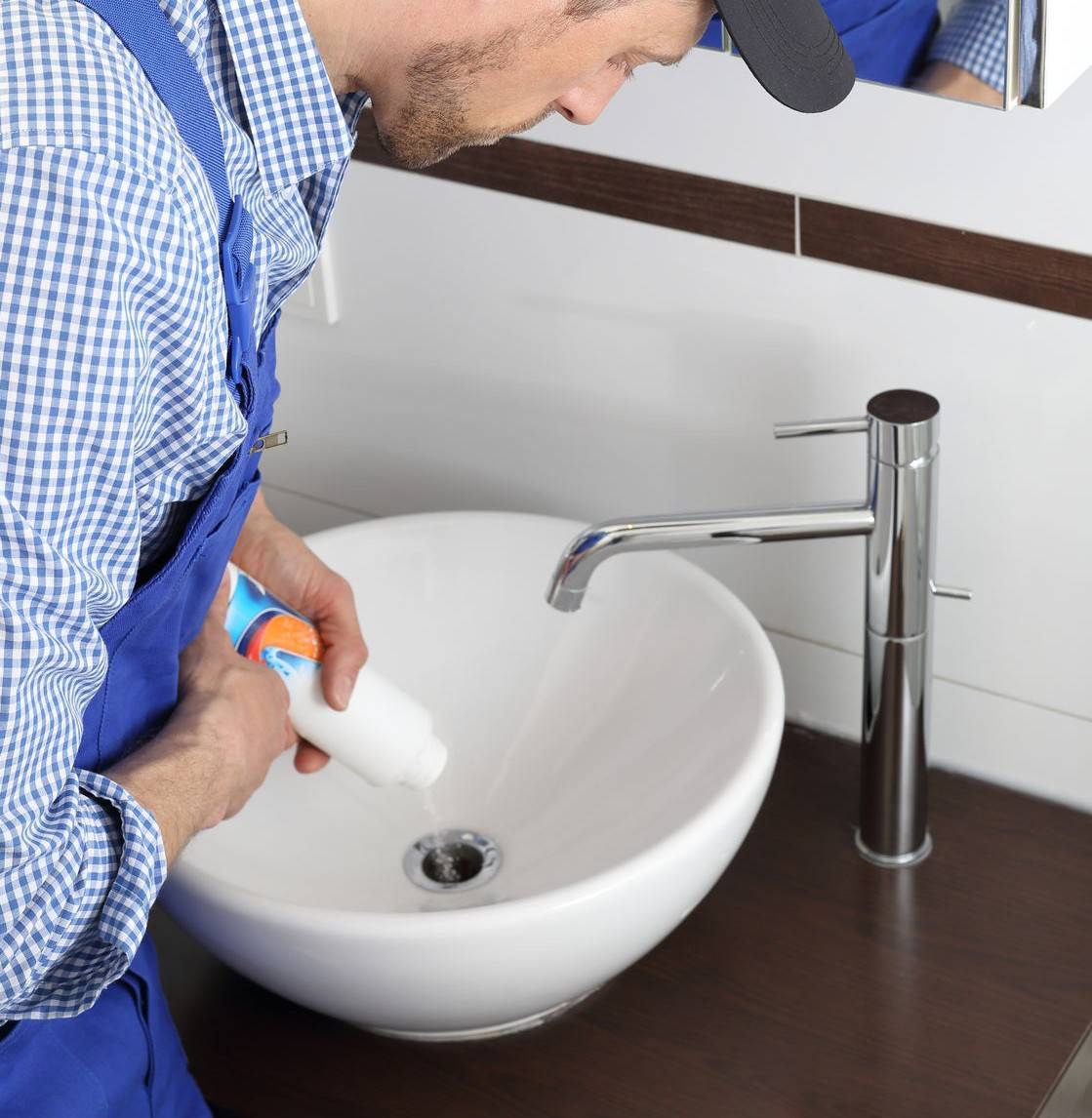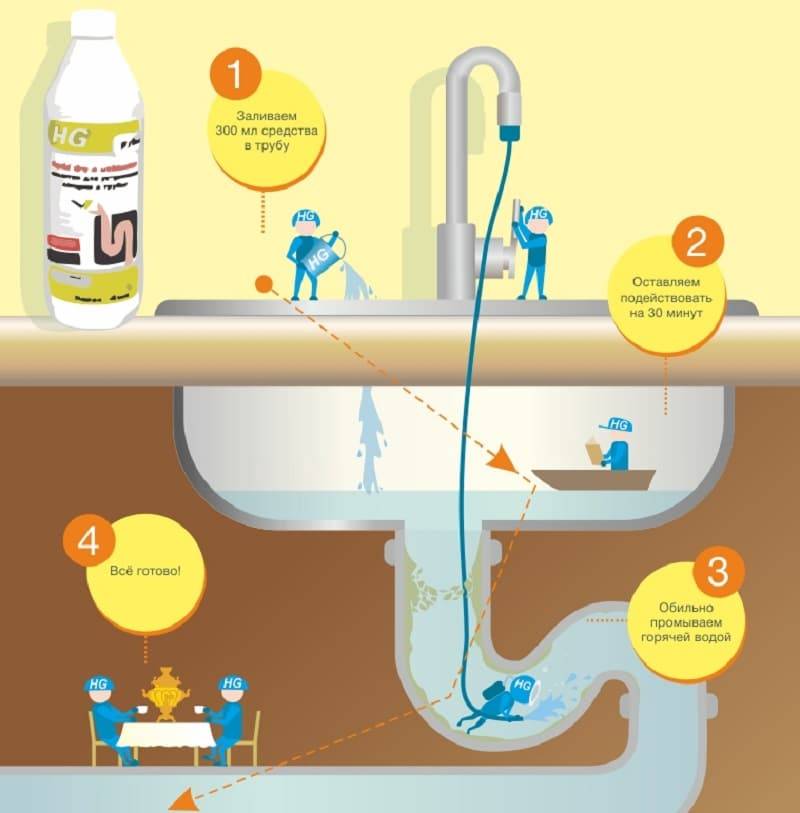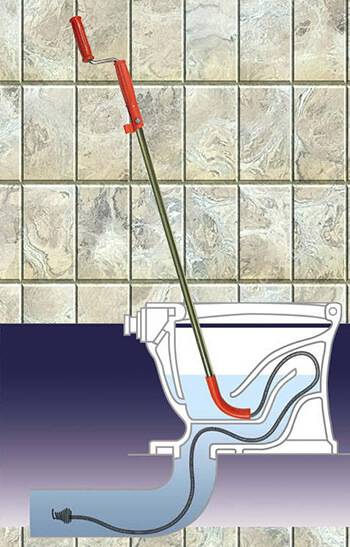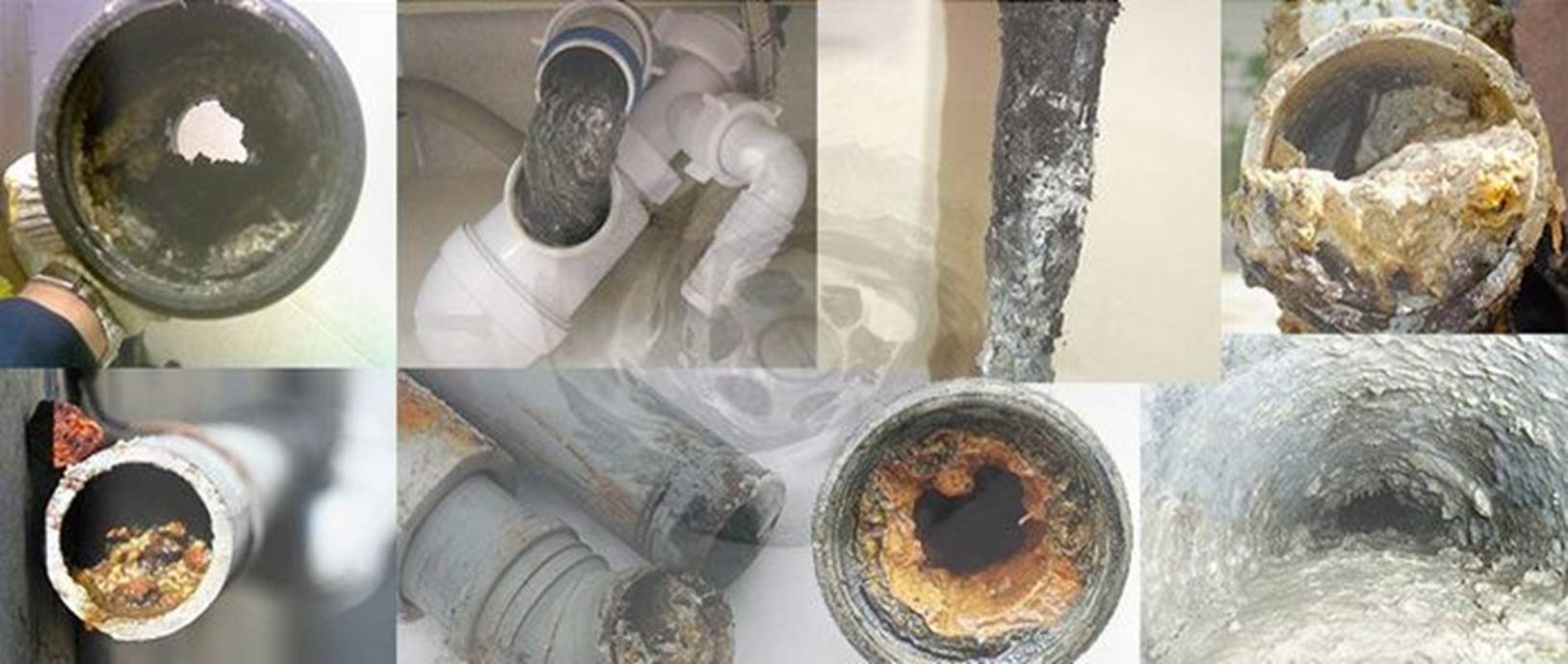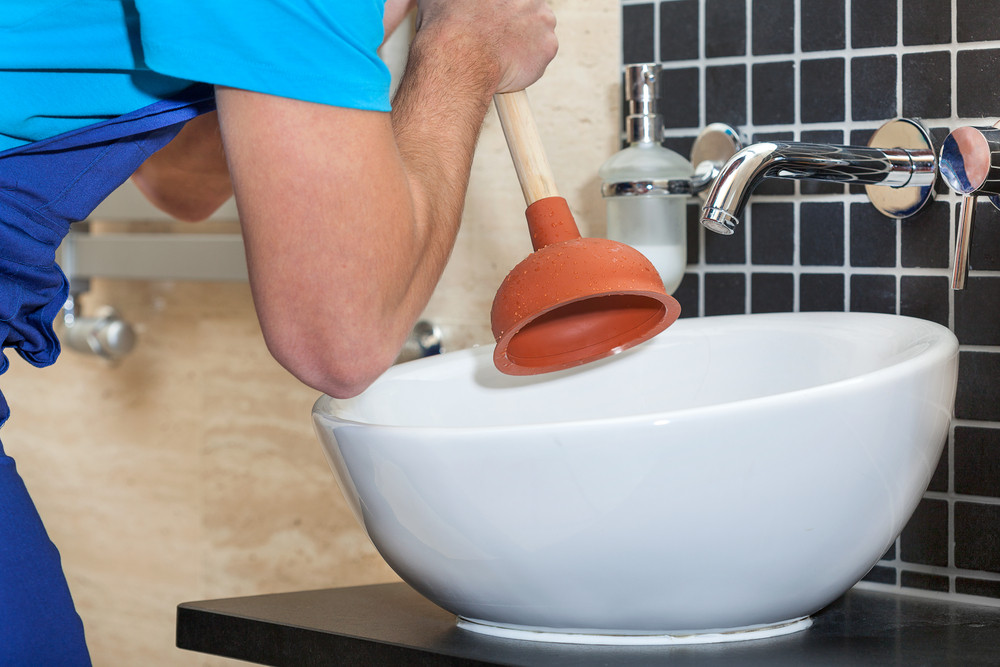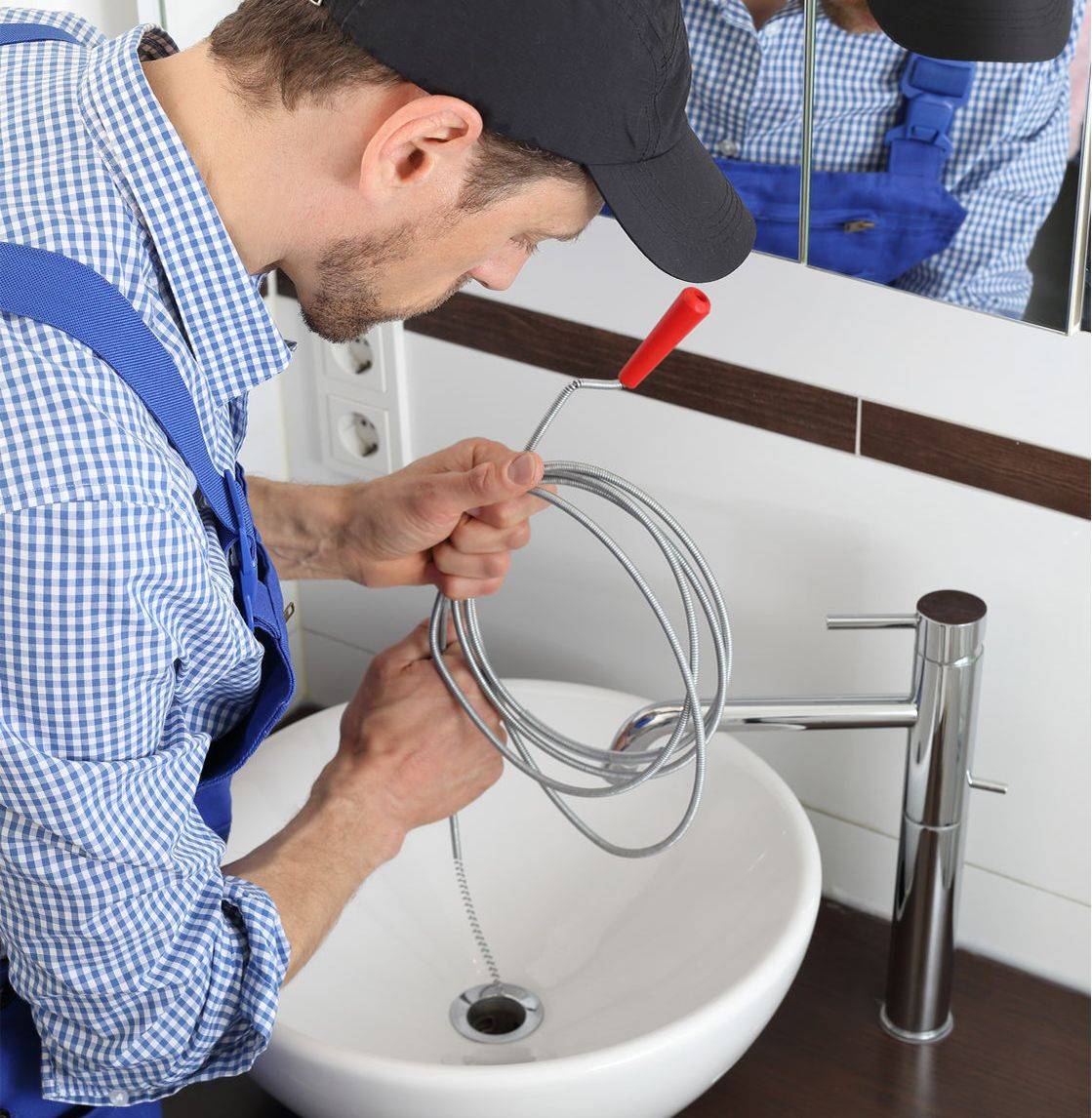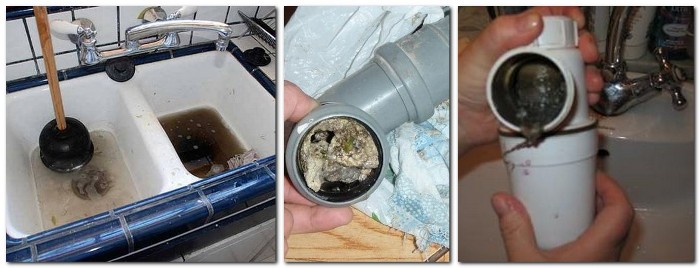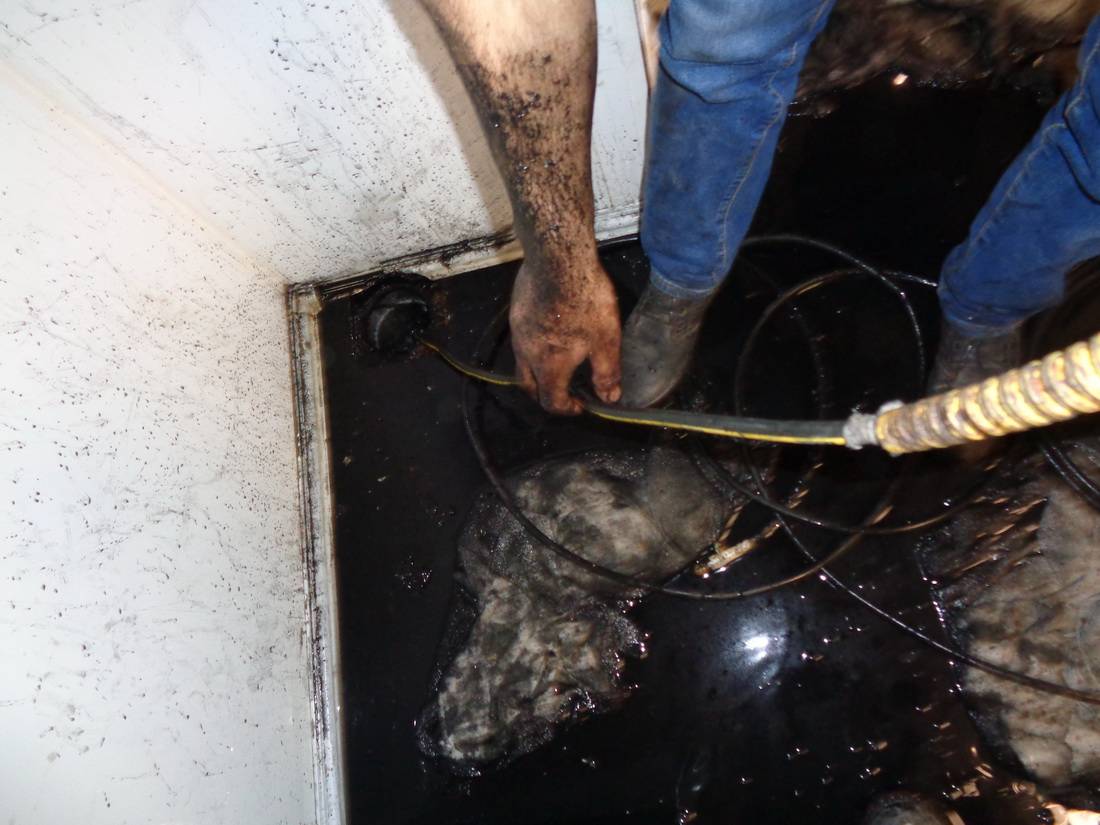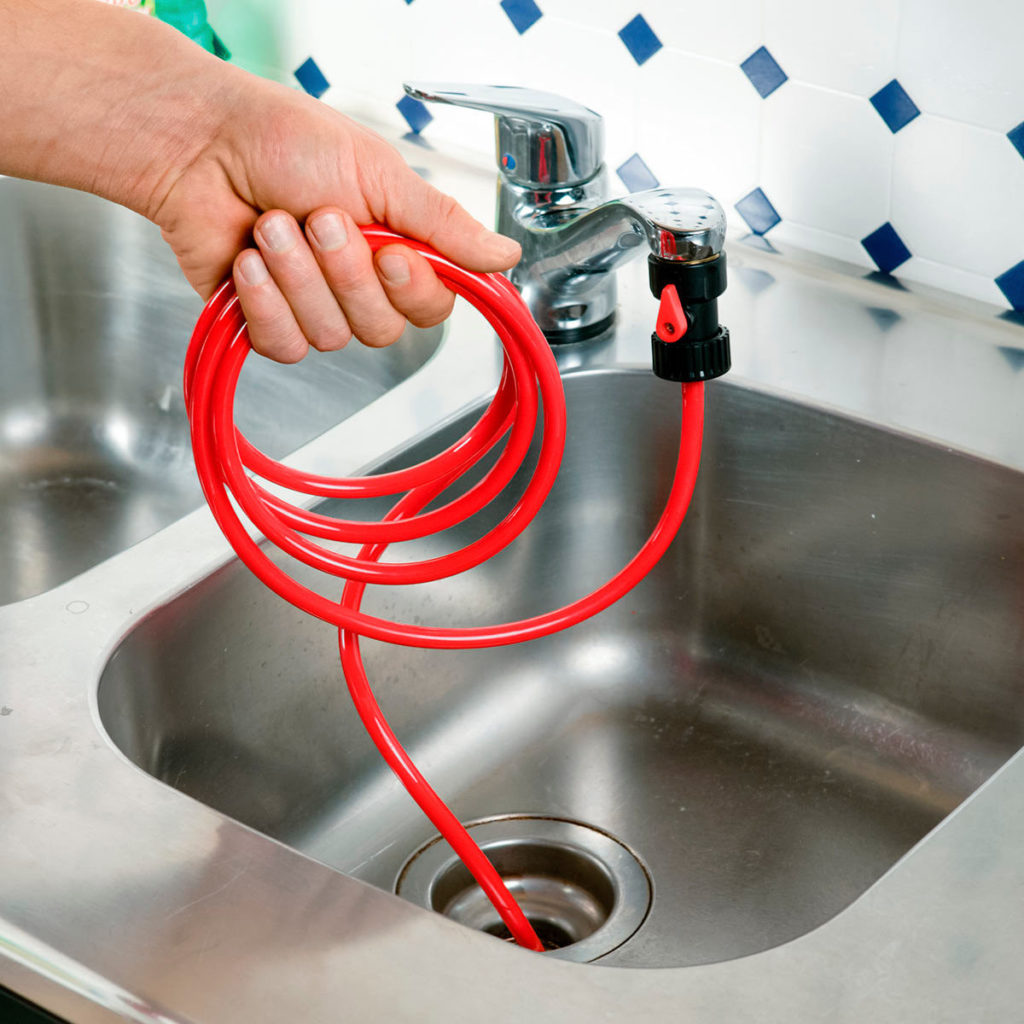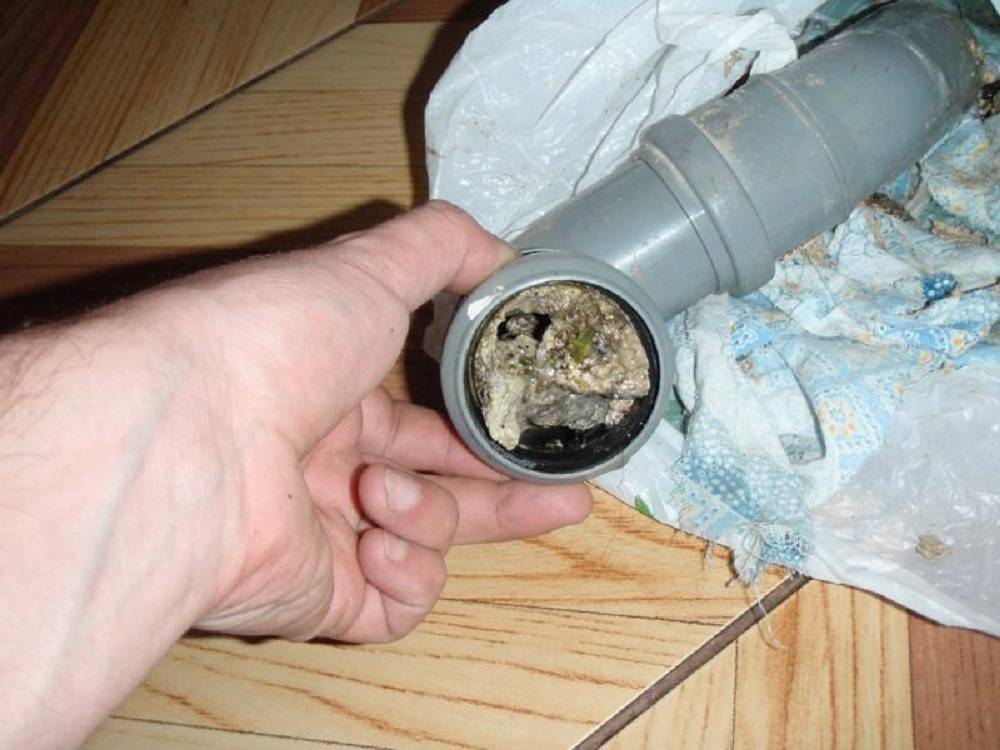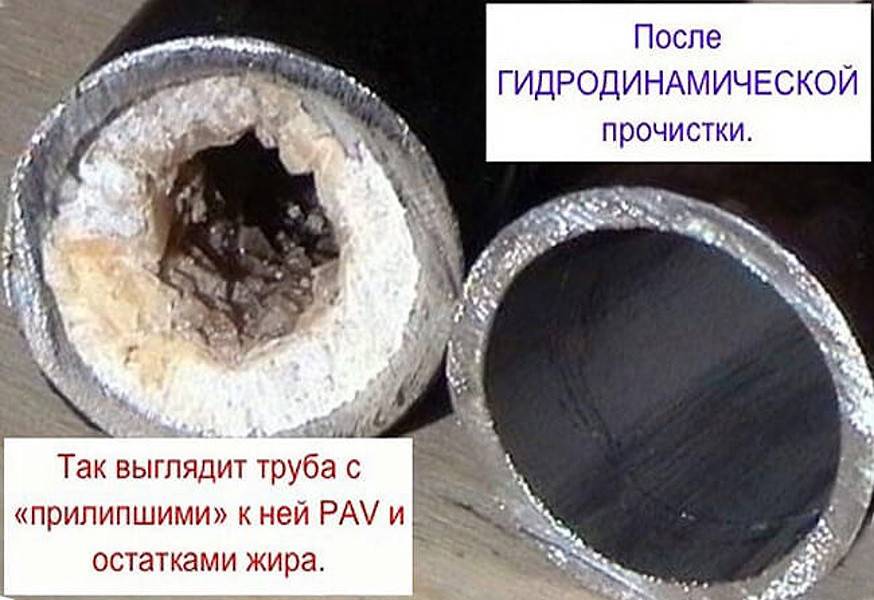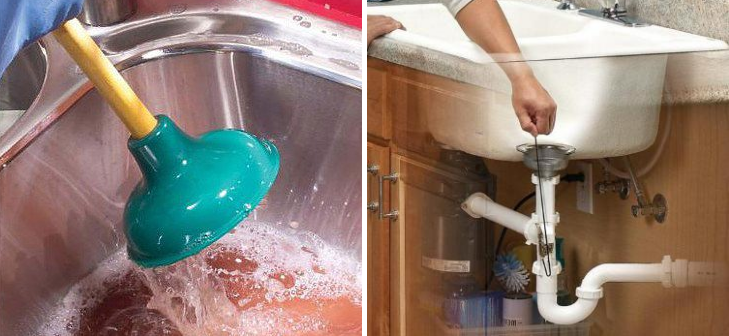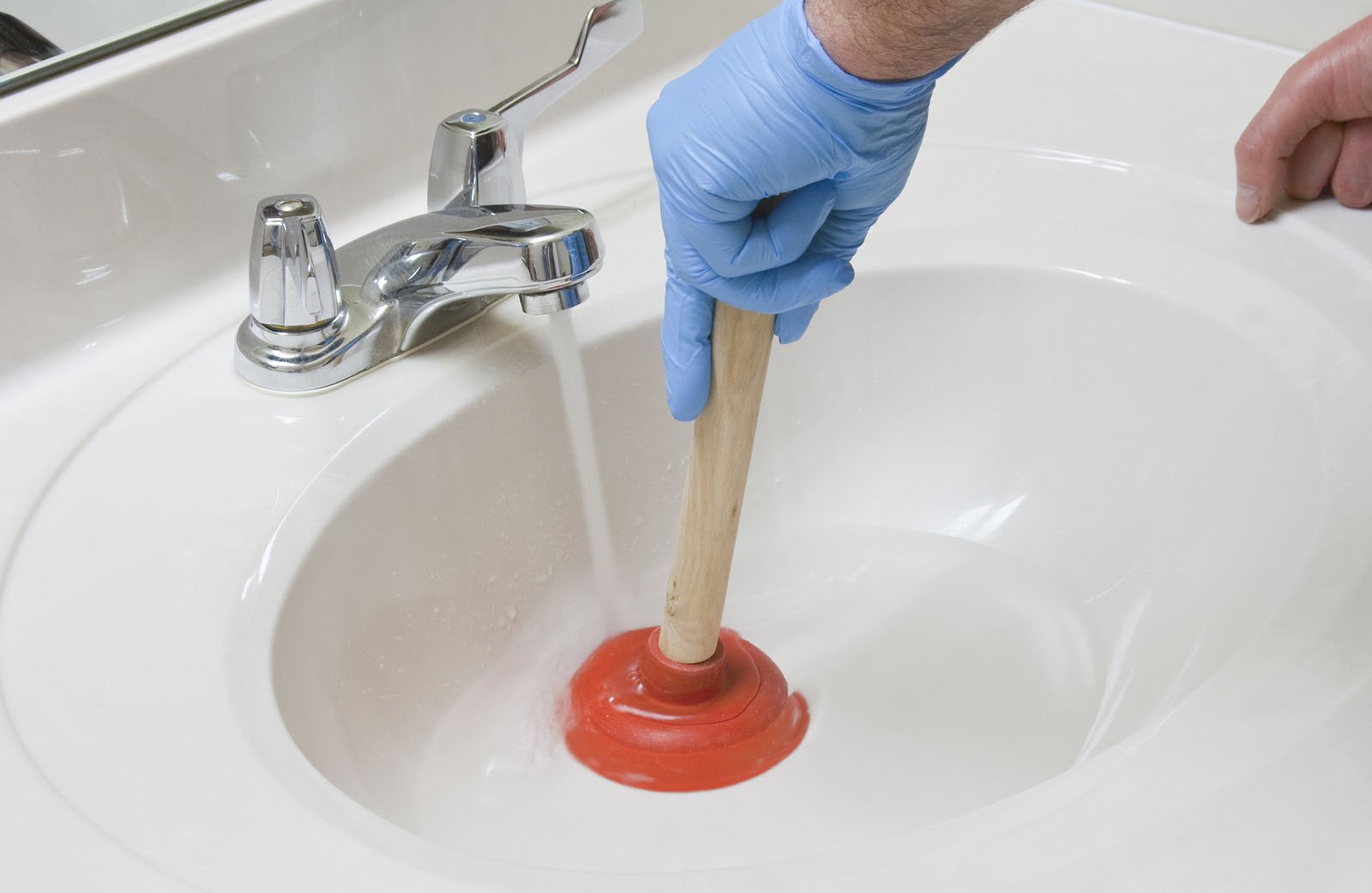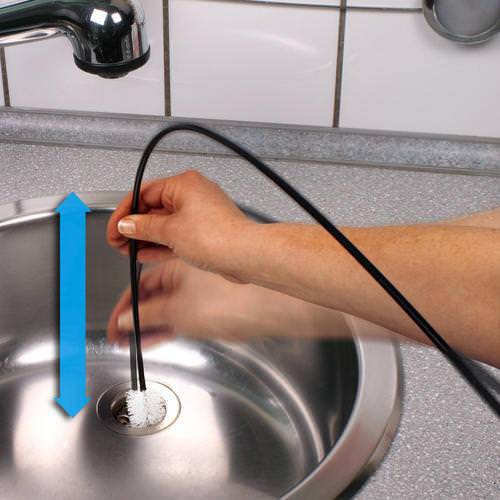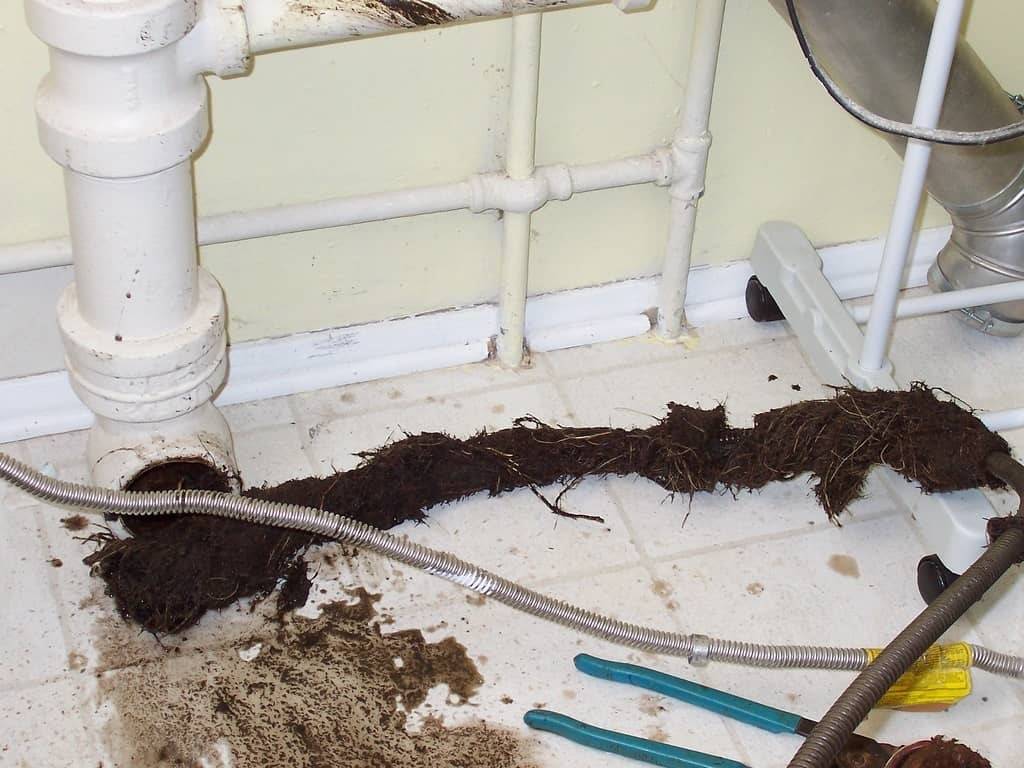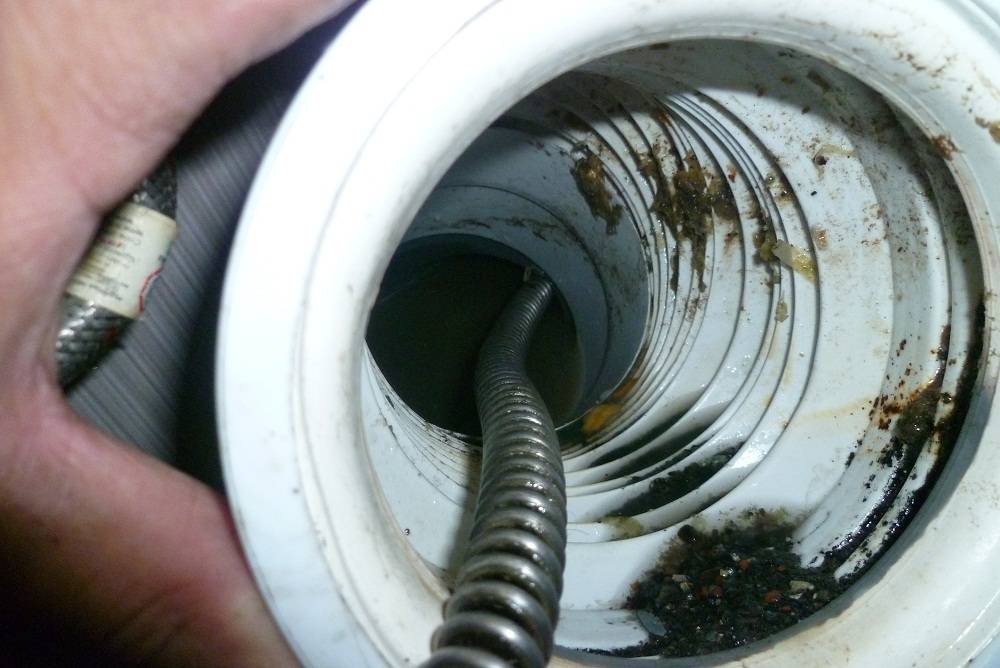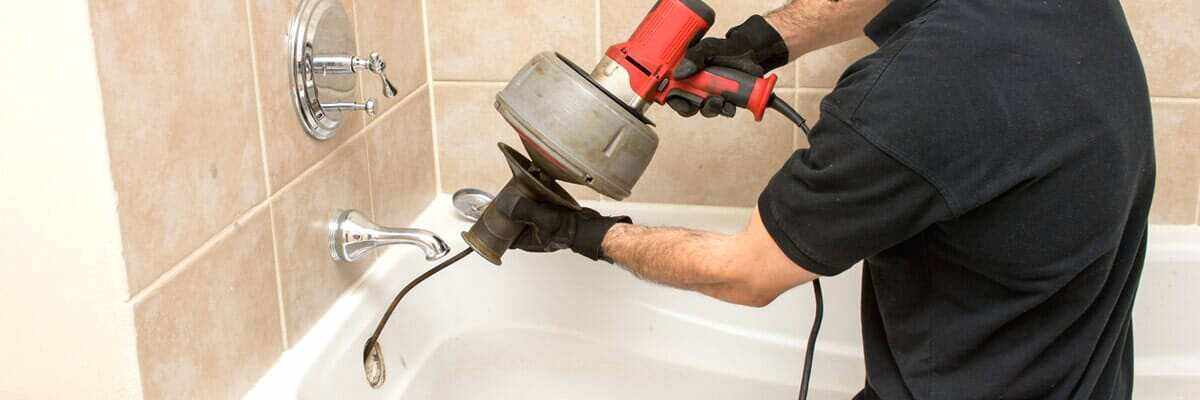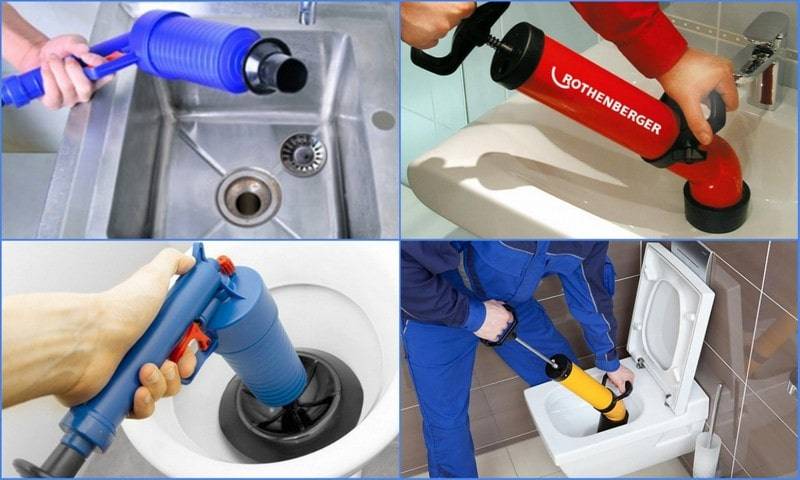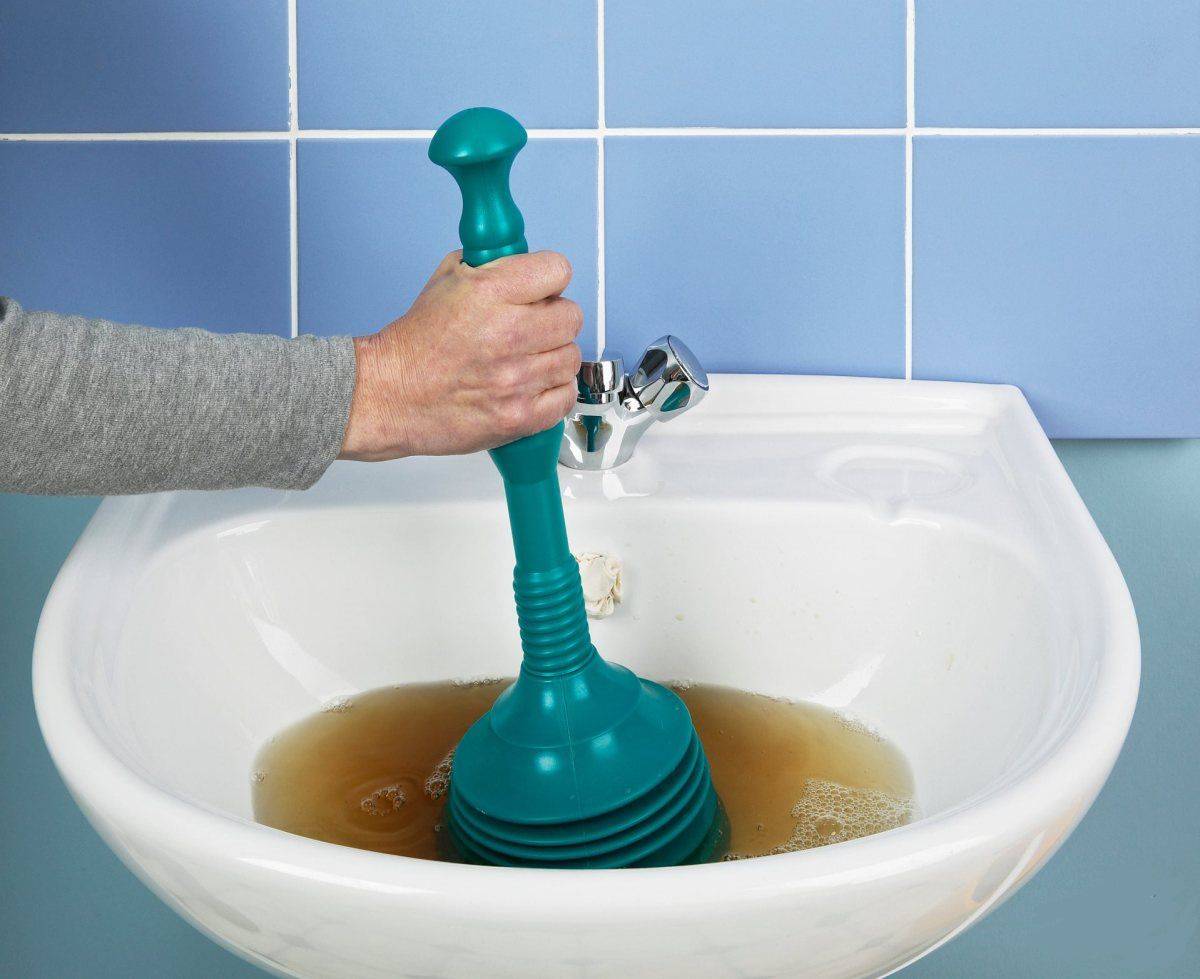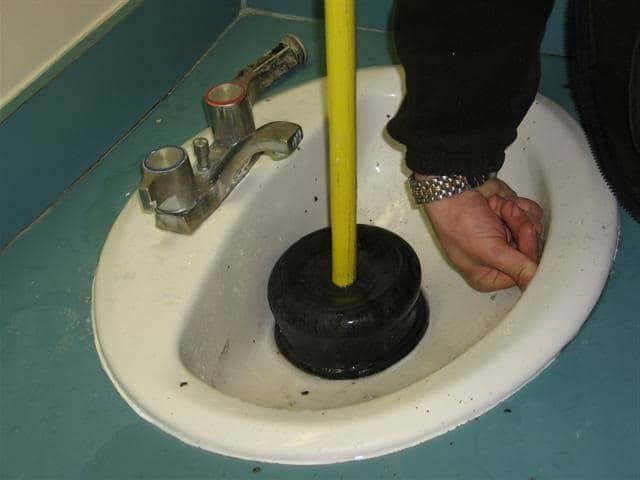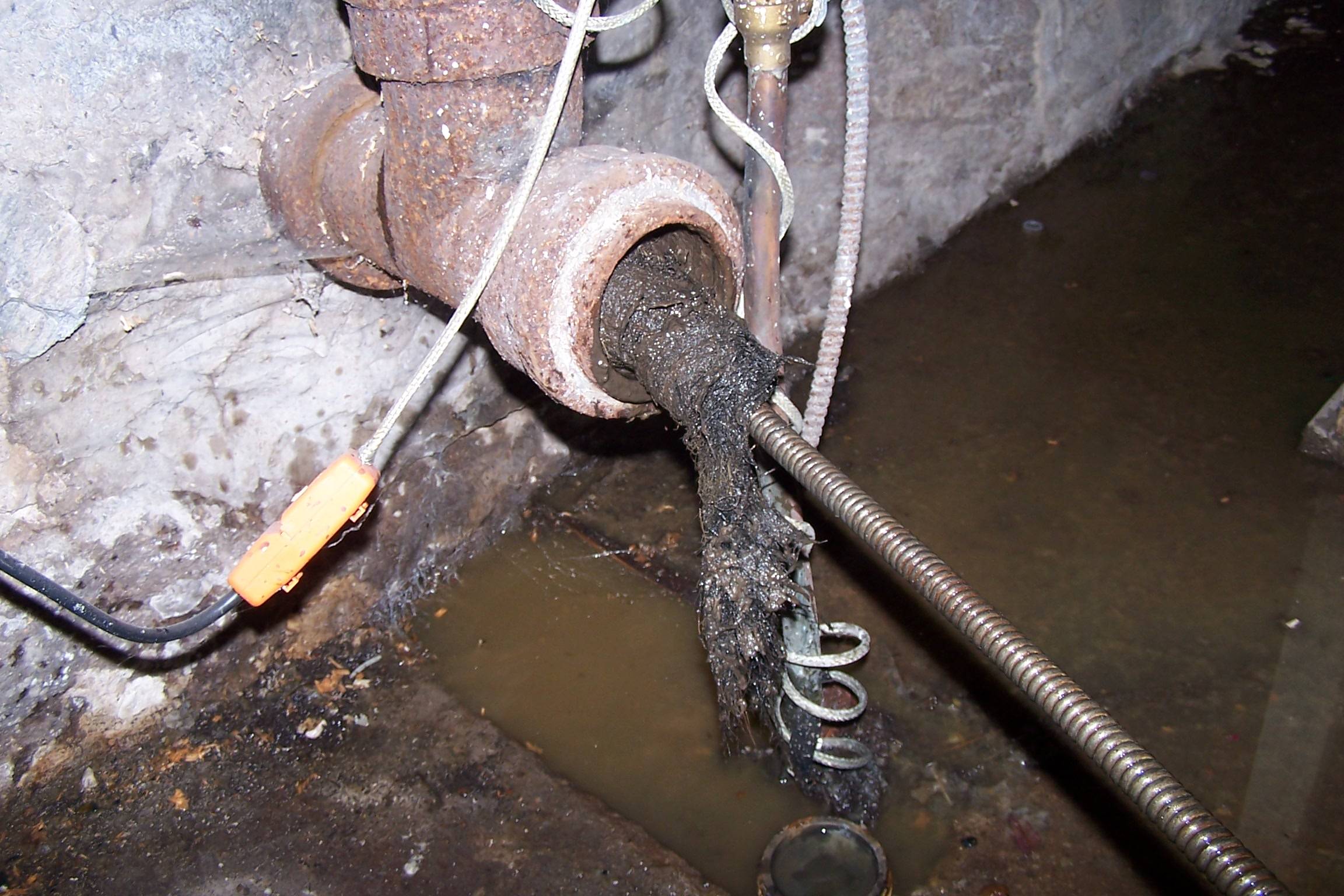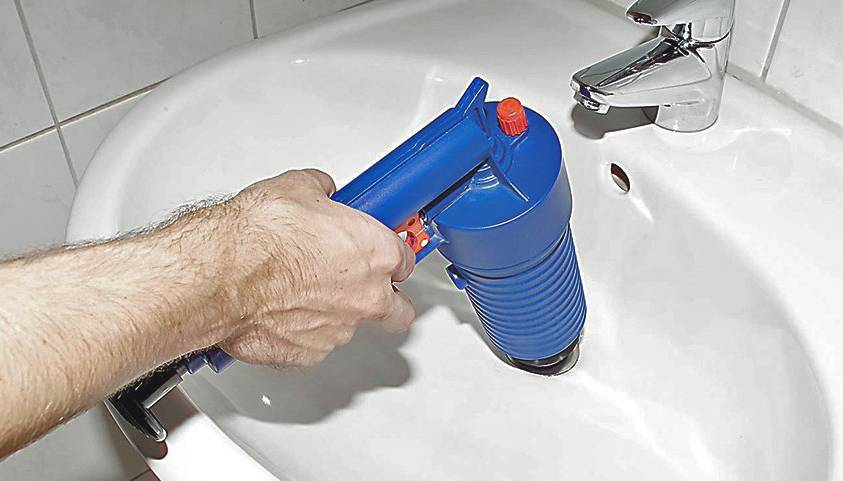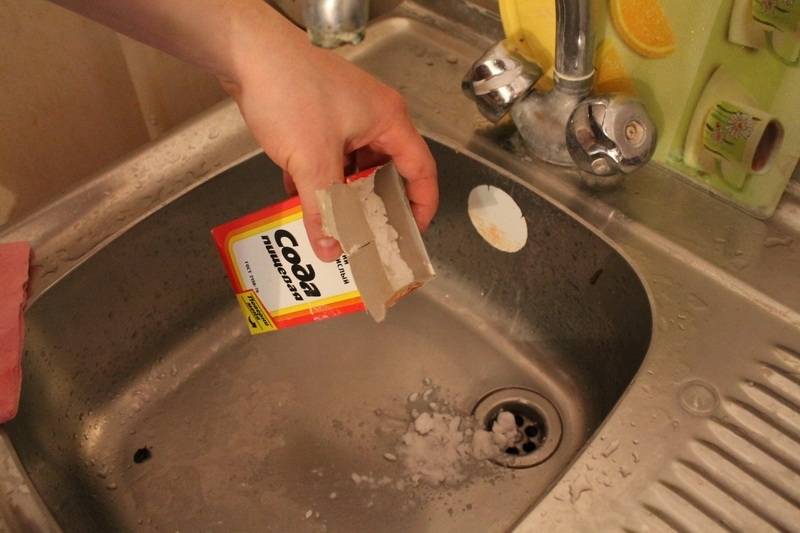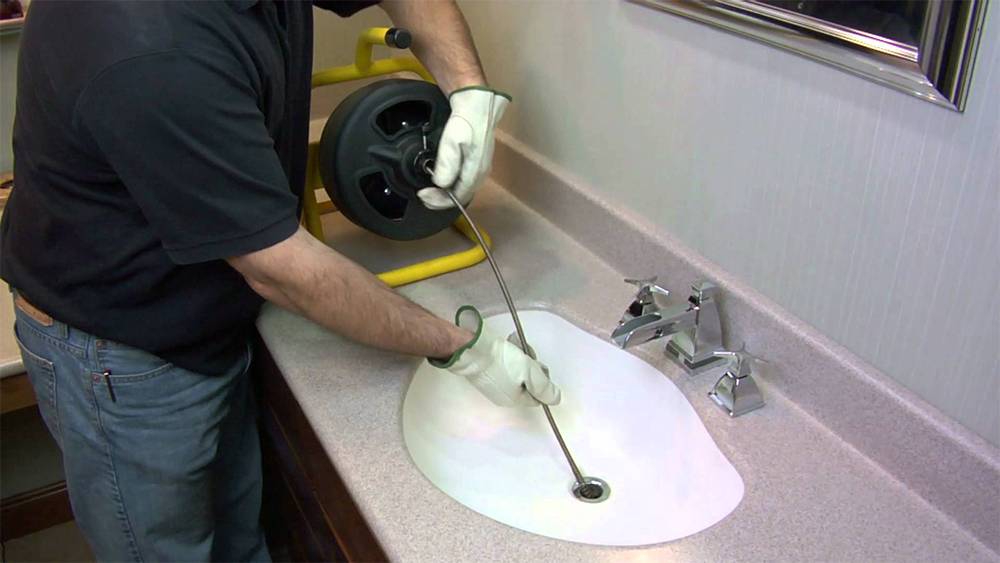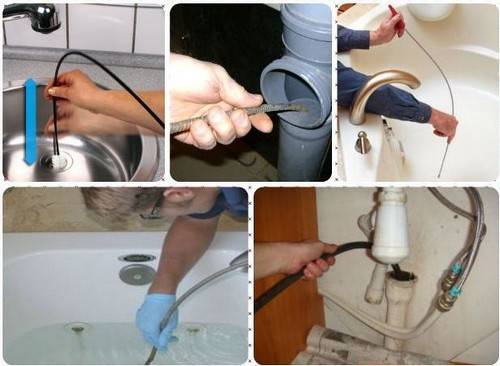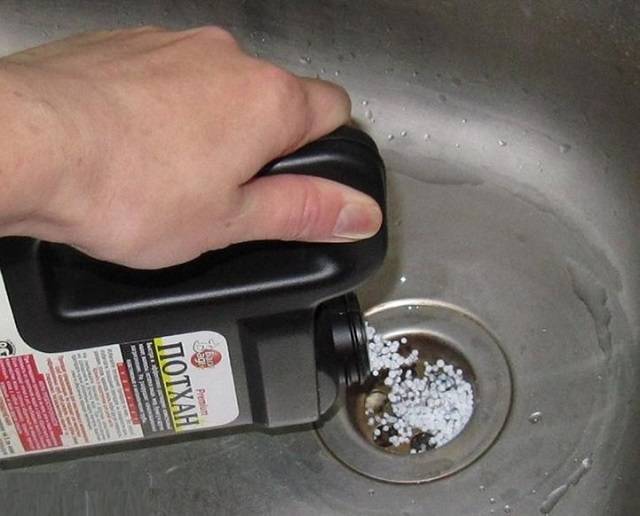How to clean a siphon
Cleaning the siphon will get rid of the accumulation of debris in the pipe and remove the unpleasant odor.
Cleaning the siphon without removing and disassembling
You can clean the siphon without removing and disassembling the structure:
A rag is spread on the floor directly under the siphon to absorb moisture.
A basin is placed on top of the fabric so that dirty water does not spill onto the floor.
Carefully unscrew the bolt nut, remove the flask
The water will begin to drain into the basin. In the meantime, the siphon is washed, removing plaque from the walls.
Reinstall the siphon
The branch pipe should not rest on the flask, so as not to violate the water seal.
How to disassemble the siphon
A universal way to remove blockage is to disassemble the siphon and rinse all parts.
Filters under the sink can prevent the siphon from being removed. It is recommended to remove them before starting work.
Dismantling the siphon:
- Before work, a bucket is placed under the sink to drain the water.
- Use a wrench to unscrew the cleaning hatch cover.
- Unscrew the sump to drain the moisture accumulated in it. If there is no access inside due to structural features, then unscrew the fasteners, remove the siphon, wait for the water to drain.
- Prepare a cable or wire with a hook at the end. They are tapped after a siphon.
- All parts are washed with hot water and detergent.
- They clean the corrugated discharge pipe above the siphon, as fat particles, hair, small debris accumulate in its folds. To eliminate the blockage, the pipe is completely straightened, straightening all the edges, removing the bend. Rinse with water.
- After cleaning, screw the elbow fold tightly into place.
- They clean the pipe under the siphon by pouring water into this section. See if she leaves. If there are no obstacles to the drain, the siphon is installed in place.
- Check if the gasket is installed evenly, otherwise leaks are possible.
Video: how to install, change and disassemble a siphon for the kitchen
What to do if the siphons in the shower stall become clogged
- Unscrew the nut from the hose, take out the gasket, remove the cover from the drain and take out the filter.
- The hose is lowered into the drain. Place a damp cloth to prevent splashing water due to pressure.
- They let lukewarm water, holding a rag and a hose. If there are no leaks and moisture leaves without difficulty, the pressure and temperature increase. After a few minutes, the water is turned off, the rag is removed, and the hose is pushed into the side drain hole.
- The water pressure is maximized, the temperature is brought to 80. If there are no problems, the water is turned on after 15 minutes.
- The pallet is washed, the watering can is fixed in place, the gasket is installed.
In this way, the clogging in the bathroom is also cleaned.
How to get rid of fatty plaques from the sewage system?
Most kitchen sinks get clogged precisely because of the grease that gets into the pipes during the washing process and accumulates there in large volumes. To break such a grease plug, you need to use drugs containing chlorine. These can be household chemicals or standard whiteness, which is poured in excess into the drain and after 60 minutes is poured with a stream of boiling water.
Their features for this type of pollution are presented below:
Chemical
To dissolve fat plugs, they make a choice in favor of preparations based on alkali. It is not necessary to carefully look for this element in the composition of the drug: it is enough to purchase a granular product or powder. In such formulations, an antiseptic is also usually contained, which quickly straightens out the consequences of a blockage.
The following remedies are effective in the fight against fat:
- Mole is the most effective and budgetary remedy, which is packaged in bags for one-time use;
- Mister Muscle - acts similarly to the Mole, but costs a little more;
- Pothan is a powerful drug that is classified as "heavy artillery". It is enough to pour it into the sink and leave it for 15 minutes, after which even the most difficult to remove blockages will be eliminated.
Chemicals are a very dangerous thing for the human body, especially the child. When using them, you must use a protective mask and thick gloves. And in apartments with small children it is completely recommended to refuse such decisions.
Mechanical
Mechanical methods are quite effective in dealing with dried fat in pipes. Most often, a plumbing cable is used. It is a long steel "rope" made up of several intertwined wires with a handle at the end.
To improve the impact on the plug, the other side of the cable is supplied with a tip in the form:
- metal brush;
- springs.
To get rid of fat plugs, the first option is better. However, the brush must be used very carefully, as it can severely damage the walls of the pipeline.
Alkaline formulations not only perfectly eliminate grease plugs, but also help well in the fight against soapy deposits. It often accumulates on the inside of the pipe in a large volume.
Methods for Removing Paper Cork
After you have independently discovered the place and cause of the blockage, you need to decide how to clean the sewer pipes at home in each individual case. If a paper cork occurs that clogs the toilet, you can use a method such as using a water hammer. As a result, a sharp increase in pressure on one side of the blockage will push the paper ball through the narrowest area.

If sewage pipes are cleaned at home, a water hammer is created using:
- Ventuza - this device covers the water mirror and produces several clicks on its handle.
- Plastic bottle - use a product with a volume of 1.5 - 2.5 liters, cutting off the bottom of it and tightening the lid.
- Rags and sticks - before clearing a blockage in the sewer, a piece of rag is folded several times and covered with a water mirror, and then sharply pressed on it with a stick. In this case, the main thing is not to overdo it, since a too strong blow can split the bowl of the plumbing fixture.
Ways to remove the blockage
There are several ways to clear the blockage:
- chemical (professional and home remedies);
- mechanical.
Chemical ready-made products
The chemical method implies the use of chemical-based products, the composition of which "corrodes" the deposits formed on the inner walls of the pipes. These funds are able to eliminate the blockage in a short time, while they are completely safe for the sewer system, regardless of what material it is made of (plastic or cast iron).
However, their use is unsafe for humans.
They should be used very carefully. It is imperative to wear rubber gloves on your hands, and on your face, preferably a mask
Since chemicals have such properties as evaporation, their vapors can burn the mucous membranes of the nasopharynx and eyes.
To avoid costly replacement of the sewer system, although once in 2 - 3 months, you need to use any chemical means of industrial production with a specific purpose for cleaning the sewage system.
Mechanical pipe cleaning method
This method implies the use of one of the following tools:
- ruff;
- plunger;
- wire;
- plumbing cable.
If the blockage is not strong and shallow, then pipe cleaning at home can be done with the help of an ordinary ruff, which is available in every home. To do this, it is necessary to push it into the sewer hole and try to break through the waste mass with sharp pressing movements.If the distance of the blockage exceeds the length of the ruff, you can use a flexible rod by attaching a ruff to it. The resulting structure must be pushed deep into the sewer pipe in order to break through the blockage.
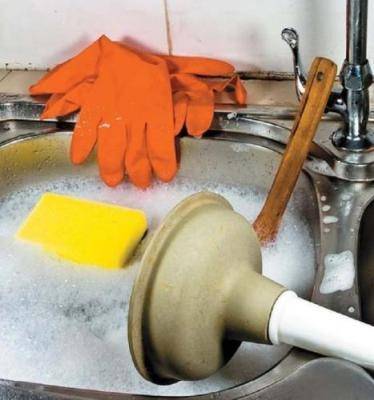
Clearing a blockage with a plunger
The plunger is also an excellent item that can penetrate the waste mass and make way for water to drain. For this you need:
- completely close the water drain hole with a plunger bowl, trying to completely block the air supply under it;
- pour water into the bathtub or sink so that it completely covers the plunger bowl;
- make 20 sharp vertical movements, the plunger handle must be kept at a slight slope;
- remove the plunger sharply from the water.
This method of cleaning the pipes must be done until the blockage is completely removed.
How to clean pipes at home using a wire or rope? Everything is very simple, for this you need:
- put gloves on your hands;
- disassemble the siphon under the sink;
- slightly push a cable or wire into the sewer hole;
- push the wire or rope in a circular motion, gradually pushing it forward until the sewage masses are completely pierced.

Cleaning pipes with a rope
If you do not have a cable or wire at hand, then in this case you can use a screwdriver or electric drill. They will effectively cope with the task.
Traditional methods of cleaning the sewer system
And now let's talk about how to clean pipes with folk remedies, and in particular with soda. This method is very simple, any housewife can use it. For this you need:
- take equal amounts of baking soda and vinegar (one glass will be enough);
- fill the sewer drain with soda, pour vinegar on top;
- close the drain with a plug and leave to act for 2-3 hours;
- flush the drain with a few liters of boiling water.
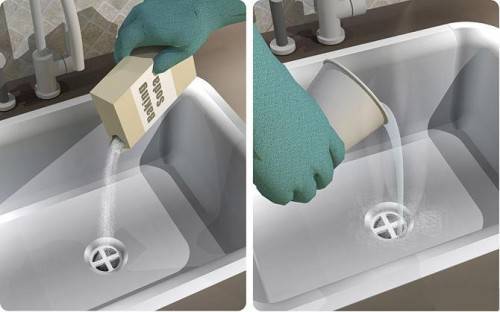
Cleaning pipes with soda and vinegar
Soda for pipe cleaning was used many years ago. This method is one of the most effective and safest. It copes with the task perfectly, while it does not harm the inner surfaces of the sewer pipes.
Cleaning of pipes with soda can occur both during clogging and for prophylaxis.
Another popular way is to use regular lemon. It is necessary to squeeze a few fresh lemons into the drain hole and leave the pipe without running water for at least an hour. You can substitute half a cup of lemon juice concentrate for fresh lemons.
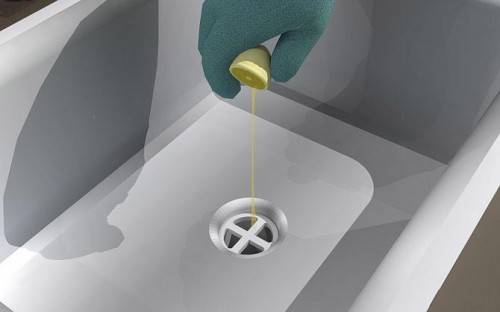
Lemon is an effective remedy that is almost always at hand
To avoid costly replacement of the sewer system, it is necessary to perform preventive cleaning of pipes at least once a quarter.
Other cleaning methods
If, after using simple home remedies, the contamination in the sink has not been removed, then the cork is too large and tight. Then they try to remove it using household chemicals or a plumbing cable. They handle dirt without disassembling the siphon.
Clearing a blockage with a plumbing cable and devices replacing it
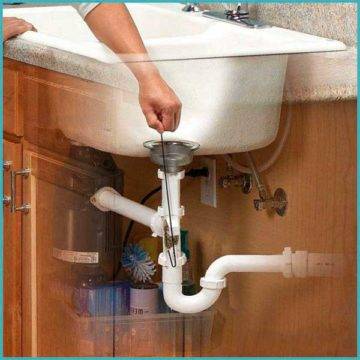
To remove the tight plug in the sink, a metal device is used, similar to a brush with a long curving handle. It is called a plumbing cable. You can purchase such a device in the economic department. It is suitable for cleaning a metal sewer pipe. Even rust on the inner walls is removed from mechanical stress. It is not recommended to use a plumbing cable for a plastic pipe, since there is a high probability of damage.
The procedure for removing the blockage:
- The device is placed in the tube and the handle is turned. If the movement comes from itself, then the blockage is pushed further into the sewer riser. In reverse rotation, the plug is taken out.
- Water is sometimes turned on when the cable is in use. It helps to flush impurities down the drain.
- After finishing cleaning, turn on hot water to wash off the remaining dirt.
Important!
If there is no cable at home, it is replaced with a homemade device made from a metal hanger. It is unbent so that a hook remains at the end. The wire is placed in the hole in the sink and the debris is cleaned out.
Household chemicals
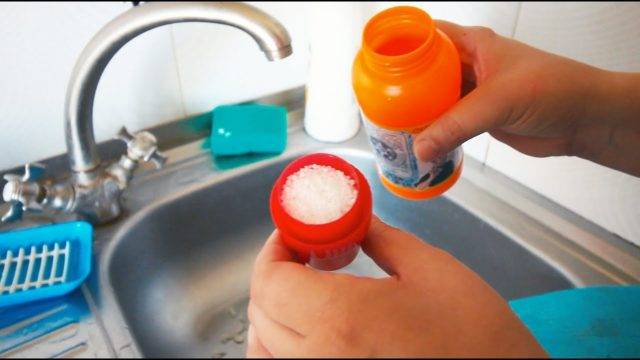
Household chemical products are used to dissolve plugs in the sewer pipe. They use acid or alkali as an active substance. These products are liquid or gel-like. Less common are dry preparations in the form of granules. When choosing a specific cleaning agent, take into account what material the pipes are made of.
Tips for using chemical solvents:
- Acids are used as active ingredients in the well-known inexpensive remedy "Krot". The drug well dissolves plugs in sewers of any nature. If the blockage is too neglected, the granular Bagi Pothan powder works better.
- Preparations in liquid form have a milder effect. Therefore, they can be used for plastic sewers.
- Before using a chemical solvent, the blockage is exposed to boiling water or a stream of hot water for 20 minutes. Then the selected product is used according to the instructions.
- Keeping a large supply of pipe cleaning supplies at home is dangerous when small children live in the home. Therefore, it is better to buy a small portion in a single-use package.
- Wear rubber gloves to protect the skin before removing the blockage. Otherwise, the chemical will corrode your hands.
- Additionally, it is recommended to open the windows so as not to be poisoned by poisonous vapors resulting from a chemical reaction.
Reasons for the formation of blockages
Before deciding how to clear the blockage in the pipe, it is worth trying to determine the reasons for its formation.
Most often, the sewer pipe in the kitchen becomes clogged due to deposits of grease that gets into the drain of the sink when washing dishes and some products. Fat gradually accumulates on the walls of the tubes, narrowing the lumen over time. Water leaves the sink worse and worse and, finally, it stops leaving completely.
A blockage can form if a large object, such as a rag or plastic bag, gets into the drain. In this case, the blockage occurs suddenly. That is, yesterday the water was leaving normally, but today it does not leave at all.
The most difficult cause of blockages to eliminate is improper assembly of the sewer pipeline. If pipes are laid without observing the optimal slope, blockages will form regularly. In this case, only the alteration of the sewer system will help.
How to clear a blockage in a bathroom
Removing a blockage in a bathtub at home is somewhat more difficult than in a sink - it is difficult to get up from below and disassemble the structure. Therefore, it will be faster and more practical to use folk remedies, read their detailed description above.
In a critical situation, you will have to resort to the help of a plunger and a metal cable.

How to unclog a toilet with a plastic bottle
Do not rush to invite a specialist in cleaning a clogged toilet, there are several ways when you can easily do it yourself. A "bearded" anecdote came to mind when a plumber, getting dirty during cleaning, indignantly says to the owners: "Are you shitting there, or what?"
For example, there are such non-standard solutions to the problem, including cleaning the blockage with an ordinary plastic bottle.
Get a regular plastic soda bottle and a sharp knife.
Procedure:
- Cut off the bottom of the bottle, but leave the cork screwed up.
- With the cut off end, immerse the bottle in the toilet bowl, in the clogged drain.
- Submerge the bottle sharply several times - the action is very similar to working with a plunger. The principle of hydraulics works in the same way - a shock occurs, which sharply increases the pressure on your side of the blockage. The pressure difference on the other side of the blockage will carry the plug into the riser.
By the way, an ordinary doormat can be a good alternative to a bottle. To get rid of the cork with its help, wet it and, folding it several times, tightly plug the toilet. Then take a mop or any stick and make as many sharp movements down the center of the rag with it to get the same water hammer.
Chemistry in the fight against pipe blockages
If all of the above methods did not help, it's time to move on to household chemicals. The stores offer a large assortment of all kinds of drugs and it is worthwhile to understand a little about their line. It:
- Acidic.
- Alkaline.
- Liquid and gel-like.
- Dry, free-flowing.
What you need to pay attention to
- Consider the material from which your pipes are made - not all products are suitable for all types, so always carefully read the instructions. Stop at universal ones, such as the Mole.
- Usually, liquid products act more gently, by the way, they are more convenient to use.
- The use of bulk materials implies undoubted observance of the instructions, they almost always suggest pouring boiling water over them, if you don’t do it, the powder can harden.
- Always work with gloves, do not bend over the plumbing equipment, after adding a product to it - a lot of heat is generated during a chemical reaction. In addition, contents may spill out of the drain.
Success, my dears, in the fight against blockages. Well, if none of the proposed methods helped, call a plumber. To help the video, it is possible that the process of cleaning the sewer pipes will become clearer. With love ... Galina Nekrasova.
Determination of the localization of the blockage
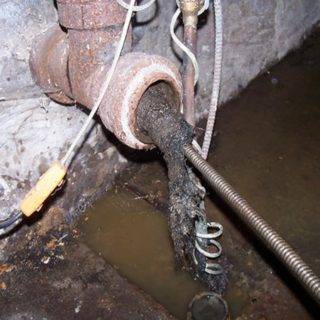 Riser blockage
Riser blockage
Before starting work, experts try to accurately determine the location of the traffic jam, find out what it consists of, in order to communicate information to the residents. Determining the location of the blockage allows you to better choose a tool or method for cleaning the pipe - chemical or mechanical.
First, they check the places where the blockage is most likely:
- Points where internal sewerage flows into external. In a newly built house, soil shrinkage is possible and concrete structures deform the plastic pipe, which leads to a decrease in its performance.
- Areas located close to the drain - siphons, elbows. Solid heavy particles usually settle in such places and block the drain.
- The site, which is located in front of the tie-in to the common highway. Blocks appear 50-60 cm before the joint.
You can independently determine the place where water does not pass by turning on the water. If the overflow begins immediately or after 2 - 4 seconds, then the plug is located in the upper part of the sewer, immediately after the siphon or in it. In this case, an unpleasant odor will be heard, since the siphon is clogged and does not perform its function.
If the water runs off normally for some time, and then the overflow begins, then the plug is located further. To remove the blockage in the sewer pipe at home, you will need a plumbing cable.
Baking soda
The best way to get rid of the cork from the fatty deposits in the pipes is to use sodium carbonate, that is, baking soda. For greater efficiency, we recommend using Russian-made soda. First pour 200 grams of baking soda into the drain hole. Then add 200 ml of vinegar and plug the hole tightly. The reaction between these substances perfectly dissolves fat, removing blockages. Wait 10-15 minutes, run hot water under strong pressure for a couple of minutes.

Thanks to the above methods of cleaning pipes from blockages, you can easily cope with this task without the help of specialists. Everything that is required is almost always at hand, and if not, then it does not cost a lot of money. Follow our advice and you won't have to put in a lot of effort.
How to clean a pipe through a drain in a bathtub, shower or toilet
To eliminate the plug in the drain pipes of the bathroom or in the toilet, you can use all of the above folk methods (with the same restrictions).But using the cable in the toilet will not work. The wire will simply run down the riser.

For a toilet, the easiest way is to use a plunger, however, it is important to choose a suitable bowl diameter
If we are talking about a shower or a bathtub, then it is recommended to begin with trying to rinse the drain with a shower hose.
Instructions:
- Remove the watering can and the rubber seal from the shower hose.
- We put a watering can on one of the drain holes and let a strong pressure of water (preferably hot).
- We rinse for 5-10 minutes. If water flows out of other drain holes, cover them with a rag.
- We repeat the procedure with all drain holes.
Where is the blockage
In order to choose the right method for cleaning the sewage system, you need to understand where the blockage has formed. To do this, we drain the water one by one at all points. If the water doesn't go away somewhere in one placethe siphon is most likely clogged. The second reason is a blockage in the pipe section, before connecting to the main sewer.
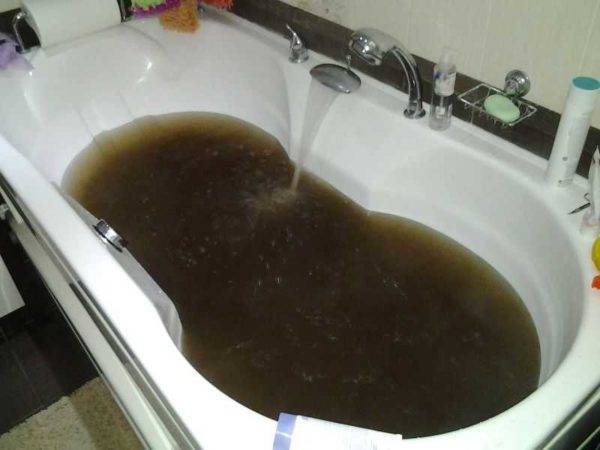
The consequences of a clogged sewer in an apartment
If the water does not leave at all, and even overflows from one device to another (you open the water in the sink, it appears in the bathroom or the level in the toilet bowl starts to rise), the general sewer outlet is clogged.
If we are talking about a private house, this is a branch to a septic tank or a cesspool, if about an apartment - this is a section to the riser or even the sewer riser itself. In the case of a blockage in a riser in an apartment, there may generally be an unpleasant situation - when the upper floors are drained, due to a plug in the sewer, it is poured into yours, rises in the bathroom, toilet. If the situation is like this - call the plumbers - you cannot cope on your own, you need powerful equipment.
If the sewage system in a private house is clogged, the first step is to check if the pit or septic tank is overflowing. If the level is not above normal, the problem is in the pipes or drain devices.
4 What do the people advise?
How to unclog a sewer at home? Folk remedies are a budget option for cleaning pipes, since the necessary ingredients are found in almost every kitchen. They can be used to clean pipes if the blockage is minor and the contamination is small. Large plugs cannot be removed in such a way, but these methods will be effective for prevention purposes.
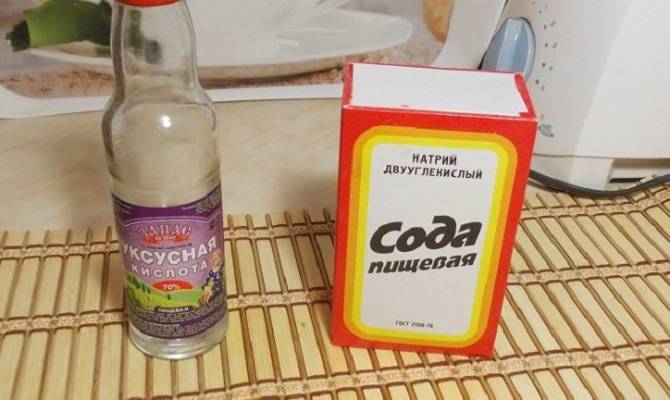 Soda and vinegar to combat blockages
Soda and vinegar to combat blockages
Using soda. Procedure:
- pour 1 glass of soda into the drain hole;
- pour 3 cups of boiling water there;
- leave overnight;
- flush the sewer system with plenty of running water.
Using "fried" soda. Such a remedy, prepared at home, will look like a Mole powder. Procedure:
- 150 g of soda must be fried in a cast-iron skillet for about 15 minutes;
- let the soda cool;
- dilute the resulting soda in 1 glass of water, stir;
- pour this mixture into the drain;
- leave overnight;
- flush the sewer system with plenty of running water.
Using baking soda and vinegar:
- pour 1/2 cup of soda into the drain hole;
- pour 1/2 cup of vinegar there;
- close the drain with a plug or rag, since a chemical reaction must occur, as a result of which foam is formed;
- leave overnight;
- flush the sewer system with plenty of running water.
Using soda and salt:
- pour soda and salt in equal amounts into the drain hole;
- pour boiling water;
- leave overnight;
- flush the sewer system with plenty of running water.
Lemon Uses:
Blockage material and control methods
Paper
A wad of paper usually gets stuck in the narrowest place - at the toilet outlet. The easiest way to remove it from there is to push it into a wider place, then the problem will disappear by itself. Most often, a plunger is used for this purpose. If you don't have a plunger at home, you can use homemade tools.
For example:
- Take a plastic bottle with a volume of 1.5-2 liters and cut off the bottom of it. If you screw the lid tightly, you can get an almost complete plunger.
- Use a simple stick or mop handle. A dense, damp cloth is wound around it. Such devices can be used in the same system as a plunger. They are pressed against the drain hole and moved up and down until the paper plug is removed.
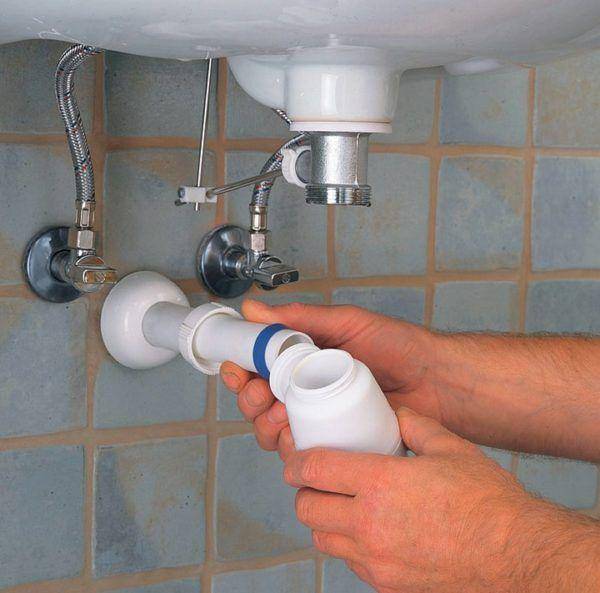
Rag
If a rag gets into the sewer system, it will only be possible to pull it out with a special plumbing cable. There should be a hook or steel fibers fluffed to the sides at one end.
When this succeeds, the cable is pulled along the same trajectory of rotation so that the rag does not break off and float into the pipe.
Hair
The problem is especially acute in apartments where several women live or have pets with abundant hair.
There are several ways to clean the bath drain from a hairball:
- Knitting needle or crochet hook. Hair hanging from the grill can be removed in parts with a knitting needle or crochet hook. The tool is simply pushed into the hole, picked up by the hair and pulled out.
- Plumbing cable. He can be safely called an assistant in any situation: a passage through the opening of the lattice, he clings to himself all the hair and pulls them out.
- Dismantling the siphon. A decisive method that is used in the most severe cases. The siphon is removed, thoroughly cleaned of hair. In this case, it is better to change the rubber seals immediately: after some time they may lose elasticity and begin to leak.
Sand
It can be building sand or dirt from the dogs' paws after walking, which tightly clogged the drain in the bathroom. The easiest way to remove such a plug is to dismantle the siphon and pour out the dirt.
In some cases, this method can be completely inconvenient: for example, if the apartment has a shower. We have to remove the top and disassemble the harness. You can simplify the task with the help of a plunger: cover the drain with it and shake the water back and forth several times. Residual sand is removed by volumetric streams of hot water.
The main causes of sewer blockages
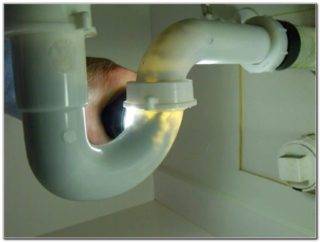 Household blockage in the siphon
Household blockage in the siphon
Service deposits build up gradually inside, resulting in obstructed water flow. In the kitchen, these are grease, food residues and powder detergents. The temperature of the water is not enough for these substances to dissolve and go into the sump. Hair is most often collected in the bathroom. The drain from the washing machine contains lint and wool.
Mechanical blockages appear suddenly. It could be toilet paper that has strayed from the toilet, or a piece of hard material caught in the pipe. More often than not, residents know what they have thrown down the drain. There have been cases when plumbers took out used diapers or clothes from the pipe.
The most difficult are technical blockages. They are caused by improper installation of the sewage system or its damage during operation, for example, when the foundation shrinks. In such cases, it is better to carry out repair work, since blockages will occur regularly and this will entail constant financial costs.

